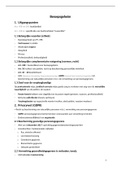Resume
Summary Strategic management
- Cours
- Strategic Management
- Établissement
- Vrije Universiteit Brussel (VUB)
(English below) Dit is een samenvatting van het vak Strategic Management, gedoceerd door Elvira Haezendonck. De samenvatting is geschreven in het academiejaar en is geschreven op basis van de hoorcolleges en het handboek. De hoofdstukken 5, 10, 12 en 14 zijn niet aan bod gekomen en staan dus oo...
[Montrer plus]













